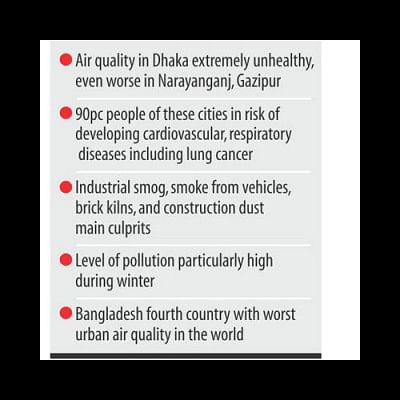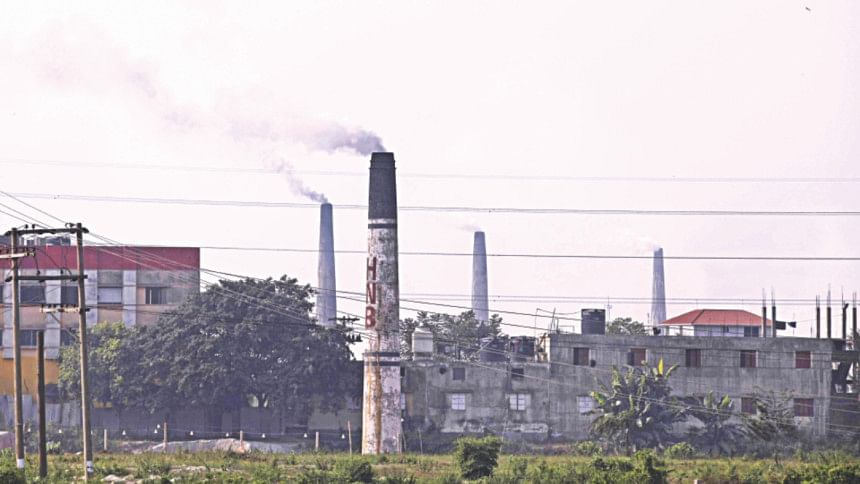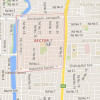Cities choke on air pollution

The quality of air in the capital is extremely unhealthy.
The presence of pollutant particles in its air even on a normal day is more than six times the healthy limit.
If this sounds scary, then you should know that the air in its neighbouring cities Gazipur and Narayanganj is even worse, according to the Department of Environment (DoE).
The level of pollution in the three cities has gone so high that the World Health Organisation has placed them among the 25 cities with the most polluted air in the world.
The DoE, under the Clean Air and Sustainable Environment (CASE) project, is measuring the air qualities in eight cities -- Dhaka, Chittagong, Sylhet, Barisal, Rajshahi, Khulna, Gazipur and Narayanganj.
The air in none of the cities is even nearly healthy.
Industrial smog, smoke from vehicles and brick kilns, and dust from construction sites are the main source of pollution in the cities, thinks Dr Manzurul Hannan Khan, director of the CASE project.
The level of pollution, as recorded by the CASE officials, is particularly high during the winter.
Asked why this happens, Manzurul said, "Rain plays a great role in cleaning the dust in the air."
“As the amount of rainfall reduces in the winter, pollution level in the air goes up."
This might be a key reason behind the rise in respiratory complications during the season, says Prof Atiqur Rahman, chairman of respiratory medicine department at Bangabandhu Sheikh Mujib Medical University (BSMMU).
“Though we haven't yet conducted any study, we for sure know that the number of respiratory patients increases very much during the winter."
What is more alarming is that the government is barely doing anything substantial to make air of the cities clean, leaving people exposed to serious health hazards.

ASSESSMENT OF AIR QUALITY
“Every day, we collect air quality data from our 11 devices set up in the eight cities. We enter the data in our software which then calculates the air quality index (AQI) value,” said Sabera Nasrin, data quality monitoring officer of the CASE project.
The DoE is following the air quality measurement standards of the US Environmental Protection Agency, she said.
As per the standards, 0-50 index value is considered good or healthy, 51-100 moderate, 101-200 unhealthy, 201-300 very unhealthy, and above 300 extremely unhealthy.
Shockingly, 300 is the minimum AQI value found in Dhaka, Narayanganj, Gazipur and Khulna cities for most part of the year, especially in the winter.
For example, on December 7, the AQI values were recorded at 330 in Dhaka, 311 in Gazipur, 438 in Narayanganj, 335 in Khulna, 168 in Rajshahi, 138 in Sylhet, 228 in Chittagong and 288 in Barisal cities.
Things get worse on a bad day.
In 2014, Narayanganj saw its AQI go as high as 590.
Though Narayanganj has the highest level of gaseous pollutants, the report shows the air of the northern metropolis Rajshahi contains the highest level of dust particles.

HOW BAD IS IT?
The WHO used the CASE project's data to prepare its global Ambient Air Pollution (AAP) report in 2014.
In the report, Bangladesh was ranked fourth among 91 countries with worst urban air quality.
And among 1,600 cities of the world, Narayanganj was identified as the 17th city with worst air quality while Gazipur and Dhaka took 21st and 23rd spots.
The report says that almost 90 percent of people in these cities are exposed to dangerous levels of air pollution, the largest single environmental health risk that killed 3.7 million people across the world in 2012.
The DoE has found alarmingly high presence of gaseous pollutants like carbon monoxide (CO), sulphur dioxide (SO2), nitrogen oxide (NOx) and ozone (O3) and methane (CH4) in the air of the cities.
However, floating micro particles in the air, called particulate matters (PM), harm people more than any other pollutants, say health experts.
The major PM components found in the major cities include sulphate, nitrates, ammonia, sodium chloride, black carbon and mineral dust.
Most damaging of the particles are those with a diameter of 10 microns or smaller as they can penetrate and lodge deep inside the lungs.
Someone with chronic exposure to such particles stand the risks of developing cardiovascular and respiratory diseases and even cancer in the lung and the urinary tract or bladder, according to the WHO.
"But the government has not taken up any major step to check pollution," said CASE Director Manzurul Hannan Khan.
"It's true that some initiatives like modernisation of the brick kilns and phasing out of old vehicles would reduce the level of air pollution level" but these processes are very slow and barely enough, he added.
"Different industries are being set up close to the cities. The Department of Environment should keep a close watch on these industries so that they cannot pollute the air," said Prof Atiqur Rahman.
By reducing the level of air pollution, Bangladesh can significantly reduce the incidence of heart diseases, lung cancers, and chronic and acute respiratory complications like asthma, they said.

 For all latest news, follow The Daily Star's Google News channel.
For all latest news, follow The Daily Star's Google News channel. 








Comments